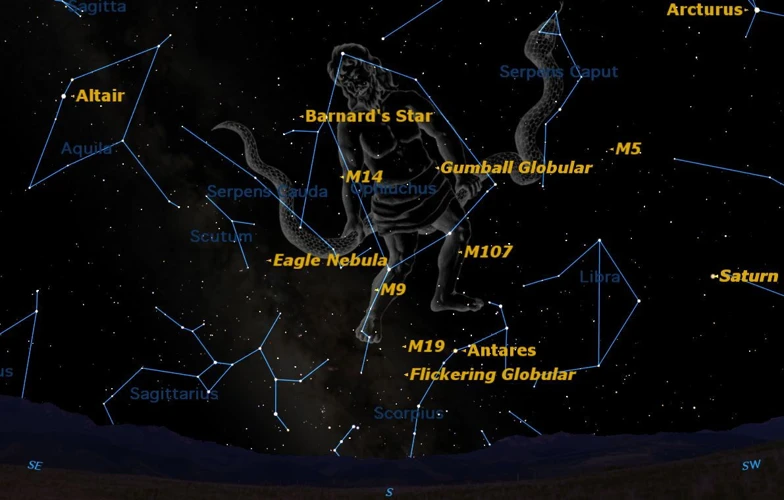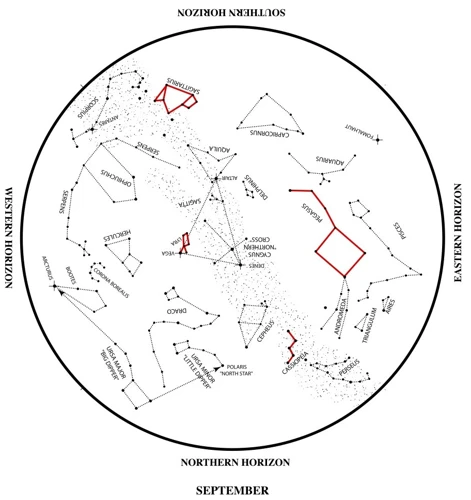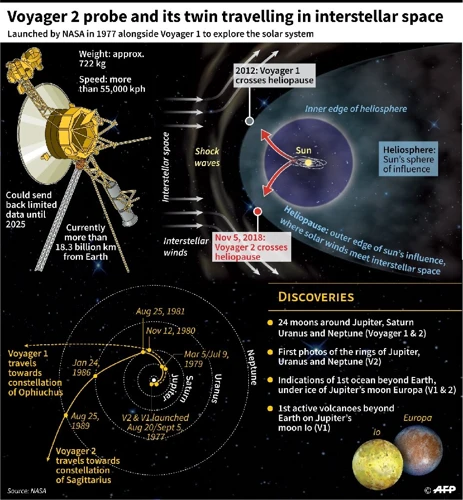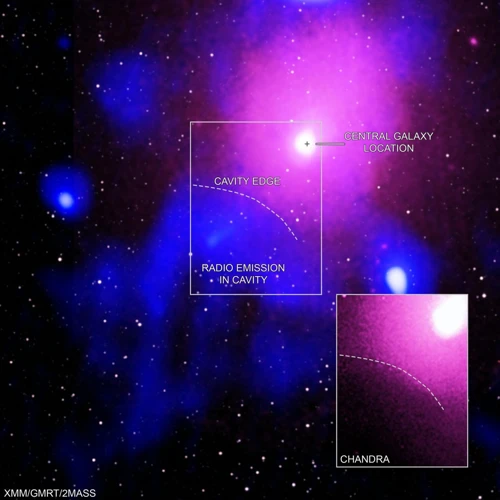The night sky has fascinated humans for centuries, inspiring stories, myths, and scientific exploration. Over time, constellations have served as guides, helping sailors navigate the vast oceans and travelers find their way. But as technology advanced, so did our ability to map and understand the stars. The introduction of modern constellations revolutionized our approach to space exploration, offering a range of benefits and opening up new possibilities. In this article, we will delve into the history of constellations, explore the impact of modern constellations on space exploration, discuss the challenges they present, and speculate on the exciting future prospects that lie ahead. So let us embark on a journey through the cosmos, where ancient knowledge and modern innovation intertwine.
Contents
- History of Constellations
- Benefits of Modern Constellations
- Impact on Space Exploration
- Challenges and Limitations
- Future Prospects
- Conclusion
-
Frequently Asked Questions
- What is the significance of constellations in ancient cultures?
- How were traditional constellations identified and named?
- What led to the evolution of modern constellations?
- How do modern constellations improve navigation systems?
- Can modern constellations aid in scientific research?
- How do modern constellations monitor climate change?
- What is the role of modern constellations in space exploration?
- What challenges do modern constellations face?
- How are spectrum congestion and interference affecting modern constellations?
- What is the future outlook for modern constellations?
- References
-
Frequently Asked Questions
- How have modern constellations revolutionized space exploration?
- What are the traditional constellations?
- What are the benefits of modern constellations?
- How do modern constellations improve navigation and positioning?
- What role do modern constellations play in scientific research?
- How do modern constellations monitor climate change?
- What impact do modern constellations have on space exploration?
- What challenges and limitations do modern constellations face?
- How can modern constellations help address future space exploration missions?
- What does the future hold for modern constellations?
- References
- Read More
History of Constellations

Throughout history, civilizations have looked up at the night sky and found patterns in the stars, creating constellations as a way to make sense of the vast expanse above. The earliest recorded evidence of constellations dates back to ancient Mesopotamia, where the Babylonians identified various star groupings and incorporated them into their mythology and astrological practices. The Greeks further expanded on this knowledge, defining 48 constellations along the ecliptic path that the Sun takes throughout the year, known as the zodiac. These constellations played a crucial role in navigation and timekeeping for seafarers and agricultural societies. With the advent of modern astronomy, the boundaries and number of constellations were refined further, leading to the adoption of the 88 recognized constellations that we use today. The history of constellations is not just a tale of stargazing and myth-making, but a testament to humanity’s desire to comprehend the cosmos and find meaning in the celestial realm.
The Traditional Constellations
The Traditional Constellations have a rich history rooted in ancient civilizations and their beliefs. These constellations were often associated with mythological stories and played a significant role in the cultures of various societies. Here are some key aspects of the traditional constellations:
1. Mythological Connection: Each traditional constellation was associated with a specific mythological character, creature, or event. For example, Orion, the Hunter, was linked to a Greek myth about a giant hunter who was placed in the stars after his death. These mythological connections added cultural significance and depth to the constellations.
2. Astronomical Significance: The traditional constellations were based on the patterns formed by groups of stars in the night sky. They provided a way for early astronomers to navigate and identify celestial objects. By recognizing familiar patterns, ancient astronomers could estimate the time of the year and predict the movements of the celestial bodies.
3. Zodiac Constellations: A subset of the traditional constellations is the zodiac constellations, which are located along the ecliptic path that the Sun appears to follow throughout the year. These constellations are associated with astrology and have been used for centuries to interpret personality traits, forecast horoscopes, and analyze compatibility between individuals (insert internal link: analyzing the impact of planetary aspects on horoscope forecasts).
4. Cultural Variations: It is worth mentioning that different cultures had their own interpretations of constellations, resulting in variations in their names and associated mythology. For example, Orion is known as Shen in Chinese astronomy, with different stories and interpretations.
The traditional constellations provide a link to our past and offer a glimpse into the imagination and ingenuity of ancient civilizations. While their astronomical significance may have evolved over time, they continue to captivate and inspire stargazers and astronomers alike.
The Advent of Modern Constellations
The advent of modern constellations marked a significant shift in our understanding and utilization of the stars. While traditional constellations were based primarily on the visual grouping of stars, modern constellations are defined by their geographical locations and technical attributes. One major contribution to this development was the implementation of the Global Positioning System (GPS) in the late 20th century. GPS is a network of satellites that enables precise positioning and navigation on Earth’s surface, revolutionizing various industries like transportation, logistics, and surveying. These satellites form a constellation in space, constantly transmitting signals that allow GPS receivers to triangulate their location. This breakthrough not only improved navigation accuracy but also paved the way for further advancements in space exploration, making it possible to precisely track the movement of spacecraft and map celestial bodies with remarkable precision. The modern constellations also include a multitude of Earth observation satellites that collect vital data about our planet’s climate, weather patterns, and environmental changes. These satellites, such as those in the Landsat and Copernicus programs, provide valuable insights into the health of our ecosystems and play a crucial role in monitoring climate change. Additionally, modern constellations encompass communication satellites that enable global connectivity and facilitate the transmission of information across vast distances. These satellites, like those operated by companies such as SpaceX and OneWeb, offer internet access to remote areas and support crucial communication networks for a range of applications, including disaster response and scientific research. The advent of these modern constellations has truly transformed our relationship with space, making it not only a domain of exploration but also an invaluable resource for enhancing our daily lives on Earth.
Benefits of Modern Constellations

Modern constellations have brought a plethora of benefits that have significantly advanced our understanding and utilization of space. One of the primary advantages lies in the improved navigation and positioning systems enabled by modern constellations such as GPS (Global Positioning System) and Galileo. These systems rely on a network of satellites that enables precise location tracking for various applications, from personal navigation devices to guiding aircraft and ships. Additionally, modern constellations have revolutionized scientific research by facilitating extensive data collection. Satellites equipped with advanced sensors and instruments gather invaluable information regarding weather patterns, climate change, and environmental factors. This data aids in forecasting, understanding natural disasters, and monitoring the health of our planet. Thus, modern constellations not only enhance our everyday lives but also play a fundamental role in addressing global challenges and shaping our understanding of the Earth and beyond.
Improved navigation and positioning systems have been one of the key benefits of modern constellations. By deploying a network of satellites in space, these constellations enable highly accurate global positioning and navigation services, such as the Global Positioning System (GPS). The satellites in these constellations transmit signals that are received by devices on the ground, allowing them to determine their precise geographic location. This has revolutionized various industries, including transportation, logistics, and surveying. Ships and aircraft can navigate with enhanced accuracy, reducing the risk of accidents and improving efficiency. Additionally, these systems have become crucial for everyday activities like driving with GPS-enabled devices that provide turn-by-turn directions. The applications extend beyond Earth, with space missions benefitting from improved navigation capabilities. Astronauts rely on precise positioning to navigate during extravehicular activities (EVA) or when docking with spacecraft. Without modern constellations, space exploration would be much more challenging and uncertain. Whether it’s guiding a lost traveler or ensuring the success of a satellite launch, the improved navigation and positioning systems made possible by modern constellations have become an indispensable part of our modern world.
Data Collection for Scientific Research
Data collection for scientific research is a vital function of modern constellations, enabling scientists to gather valuable information about our planet and the universe. Through advanced satellite systems, modern constellations provide a wealth of data across various scientific disciplines. Here are some key aspects of how modern constellations contribute to scientific research:
1. Earth Observation: Modern constellations equipped with remote sensing instruments capture high-resolution images and gather data about our planet’s land, oceans, and atmosphere. This data is crucial for studying climate change patterns, monitoring deforestation, analyzing ocean currents, tracking urban growth, and understanding natural disasters such as hurricanes and wildfires.
2. Environmental Monitoring: By monitoring environmental factors such as air quality, water pollution, and vegetation health, modern constellations contribute to environmental research and conservation efforts. The data collected helps scientists assess the impact of human activities on ecosystems, develop strategies for sustainable resource management, and identify areas that require conservation interventions.
3. Weather Forecasting: Constellations play a significant role in improving weather forecasting capabilities. The data they collect, including atmospheric temperature, moisture content, wind patterns, and cloud formations, helps meteorologists create more accurate weather models and predictions. This information is essential for early warning systems, agricultural planning, and disaster preparedness.
4. Astronomy and Space Exploration: Modern constellations not only observe Earth but also contribute to astronomical research and space exploration. By detecting and analyzing celestial objects, constellations aid in discovering exoplanets, studying distant galaxies, and unraveling the mysteries of the universe. They provide vital data for astronomers and space agencies seeking to understand cosmic phenomena and plan future missions.
5. Mapping and Surveying: The precise positioning capabilities of modern constellations are invaluable for mapping and surveying the Earth’s surface. They assist in creating detailed elevation models, mapping land use patterns, conducting archaeological surveys, and supporting infrastructure development projects. This data enables accurate cartography, urban planning, and resource management.
Modern constellations have revolutionized scientific research by providing an unprecedented wealth of data. The insights gained from these observations contribute to a better understanding of our planet, its resources, and the broader cosmos. The availability of such data opens up new avenues for scientific discovery and innovative solutions for addressing global challenges. By harnessing the power of modern constellations, scientists can continue pushing the boundaries of knowledge and exploring the wonders of the universe.
Monitoring Climate Change and Environmental Factors
Modern constellations have proven to be invaluable tools in monitoring climate change and environmental factors. With their advanced imaging capabilities and remote sensing technology, these constellations can capture detailed data about the Earth’s surface and atmosphere, providing scientists with critical information to study and mitigate the effects of climate change. Satellites equipped with sensors that detect changes in temperature, vegetation patterns, and ice coverage can track the shifts in ecosystems and natural resources over time. This data helps researchers assess the health of forests, monitor the melting of polar ice caps, and detect changes in ocean currents and sea levels. Additionally, modern constellations aid in monitoring atmospheric conditions such as air pollution, ozone levels, and greenhouse gas emissions. This information contributes to a better understanding of the impact of human activities on the environment and enables policymakers to make informed decisions to protect our planet’s well-being. By continuously monitoring climate change and environmental factors, modern constellations play a crucial role in both raising awareness about our changing world and informing strategies to address these global challenges.
Impact on Space Exploration

Modern constellations have had a profound impact on space exploration, opening up new possibilities and enhancing our understanding of the universe. One of the key benefits is the enhanced communication and data transfer capabilities provided by these constellations. With a network of interconnected satellites, information can be relayed across vast distances, enabling real-time communication with astronauts in space, ensuring smooth operation of missions, and facilitating the transfer of valuable data back to Earth. Additionally, modern constellations have played a crucial role in targeting future missions and explorations. By precisely mapping the position and movement of celestial objects, scientists and engineers can plan and execute missions with greater accuracy and efficiency. This has resulted in successful space missions to distant planets, moons, and asteroids, providing us with invaluable knowledge about the solar system and beyond. The impact of modern constellations on space exploration is undeniable, offering the tools and infrastructure necessary for humanity to venture further into the cosmos and unravel its mysteries.
Enhanced Communication and Data Transfer
In the realm of space exploration, modern constellations have had a transformative impact on communication and data transfer. With the establishment of constellations of communication satellites, such as the iconic Iridium and the recently launched Starlink, the efficiency and reach of global communication networks have been greatly enhanced. These constellations consist of hundreds or even thousands of interconnected satellites that orbit the Earth, forming a vast network of communication nodes. Through this network, individuals, businesses, and organizations can access high-speed internet, make phone calls, and transfer data across long distances, even in remote areas or during natural disasters. This improved connectivity is crucial for space missions, enabling astronauts and scientists to transmit valuable data and communicate with mission control and research teams in real-time. Additionally, these constellations play a vital role in enabling global collaboration and coordination among international space agencies, facilitating the exchange of information, ideas, and discoveries. Such enhanced communication and data transfer capabilities are not only benefiting space exploration but also have far-reaching impacts on various sectors such as telecommunication, disaster management, and remote sensing. As technology continues to evolve, the possibilities for further advancements in communication and data transfer through modern constellations are boundless, promising a future where connectivity knows no boundaries.
Targeting Future Missions and Explorations
Targeting future missions and explorations is an essential aspect of space exploration, and modern constellations play a significant role in enabling these endeavors. With their advanced tracking and communication capabilities, these constellations provide crucial support for planning and executing missions to outer space. By precisely determining the positions of satellites and spacecraft, modern constellations help calculate optimal trajectories and orbital maneuvers, conserving valuable fuel and resources. The high-speed data transfer facilitated by these constellations allows for real-time monitoring and control of missions, ensuring the safety and success of astronauts and robotic probes alike. In addition to aiding current space missions, modern constellations also serve as a foundation for future explorations, providing the infrastructure necessary for extended deep-space missions, lunar settlements, and ambitious projects such as Mars colonization. As we venture further into the cosmos, the precise positioning and communication capabilities offered by modern constellations will continue to revolutionize space travel and expand our understanding of the universe.
Challenges and Limitations

While modern constellations have brought numerous benefits to space exploration, they also pose their fair share of challenges and limitations. One significant challenge is the issue of space debris and collision risks. With an increasing number of satellites and constellations orbiting the Earth, the accumulation of defunct satellites, spent rocket stages, and other debris poses a threat to active satellites and spacecraft. Efforts are being made to mitigate this risk through tracking and monitoring systems, as well as initiatives to actively remove space debris. Another limitation is the issue of spectrum congestion and interference. As more constellations are deployed, the demand for radio frequencies and bandwidth increases, leading to potential conflicts between different systems and services. This challenge requires careful coordination and allocation of spectrum resources to avoid interference and ensure the seamless operation of various satellites and communication networks. Overcoming these challenges will be vital for the continued success and sustainability of modern constellations in shaping the future of space exploration.
Space Debris and Collision Risks
Space debris and collision risks pose significant challenges to modern constellations and space exploration as a whole. The increasing number of satellites and spacecraft in orbit has led to a growing amount of space debris, including defunct satellites, spent rocket stages, and fragments from previous missions. This debris poses a serious threat to operational satellites and spacecraft, as even small pieces of debris can cause catastrophic collisions. The consequences of such collisions can include the destruction of valuable assets, interruption of critical services like communication and weather forecasting, and the generation of even more debris through the cascading effect known as the Kessler Syndrome. To mitigate this risk, space agencies and satellite operators employ various measures, including careful mission planning to avoid high-density debris areas and the development of technologies to track and monitor space debris. Additionally, initiatives such as the removal of defunct satellites and debris from orbit are being explored to reduce the overall clutter surrounding Earth. The challenge of space debris and collision risks is an ongoing concern that requires international collaboration and innovative solutions to ensure the sustainability of space activities and the long-term viability of modern constellations.
Spectrum Congestion and Interference
Spectrum congestion and interference pose significant challenges to the effective utilization of modern constellations for space exploration. As more satellites are launched into orbit, the limited frequency spectrum available for communication and data transfer becomes increasingly congested. This congestion can result in signal interference, decreased signal quality, and reduced data transmission rates. The problem is compounded by the fact that different countries and organizations allocate and utilize the frequency spectrum in different ways, leading to potential conflicts and overlapping usage. The increasing number of constellations also raises concerns about the potential for collisions and the creation of space debris, further exacerbating the interference issue. Resolving spectrum congestion and interference requires international coordination and cooperation to establish standardized frequency usage and allocation, as well as the development of advanced technologies that can mitigate interference and optimize spectrum usage. Scientists and engineers are actively exploring innovations such as adaptive beamforming, advanced modulation techniques, and cognitive radio systems to address these challenges and ensure the efficient operation of modern constellations. By overcoming spectrum congestion and interference, we can maximize the potential of space exploration and enable seamless communication and data transfer between Earth and satellites for scientific research, exploration missions, and everyday applications.
Future Prospects

The future of constellations holds immense promise, with advancements in technology shaping the way we explore and understand the cosmos. One significant area of development is the integration of artificial intelligence (AI) and machine learning. By combining the power of AI algorithms with the vast amount of data collected by modern constellations, scientists can gain deeper insights into celestial phenomena and uncover new discoveries. This fusion of human intelligence and advanced computing opens doors to analyzing complex planetary alignments, identifying patterns, and even predicting potential conflicts, such as the historical significance of planetary alignments in wars. Additionally, the miniaturization of satellites and the rise of nanosatellites offer exciting prospects for constellations. These small yet powerful devices can be deployed in larger numbers, enabling a more comprehensive coverage of the sky and fostering collaborations between different nations and organizations. As we venture further into the unknown reaches of space, the future of modern constellations will continue to push boundaries, unravel mysteries, and expand our understanding of the universe.
Integration with Artificial Intelligence and Machine Learning
Integration with Artificial Intelligence (AI) and Machine Learning (ML) technologies has the potential to revolutionize the field of modern constellations and space exploration. AI and ML algorithms can analyze vast amounts of data collected by satellites and constellations, providing valuable insights and generating actionable information. One area where AI and ML can make a significant impact is in data processing. The sheer volume of data generated by modern constellations can be overwhelming for traditional analysis methods. However, with AI and ML, patterns, anomalies, and correlations can be detected more efficiently and accurately. These technologies can also assist in real-time decision-making by quickly identifying and responding to dynamic situations, such as satellite malfunctions or space debris threats. Additionally, AI and ML algorithms can optimize the performance and efficiency of constellations by continuously learning and adapting operations based on changing environmental conditions or mission requirements. With the incorporation of AI and ML, constellations can become more intelligent, self-aware systems capable of self-monitoring, self-diagnosing, and self-healing. This integration not only enhances the capabilities of modern constellations but also paves the way for innovative applications and discoveries in space exploration. The power of AI and ML technologies combined with the vast amount of data from constellations holds the key to unlocking new frontiers in understanding the universe and further advancing our exploration efforts. /exploring-ophiuchus-compatibility-zodiac/
Advancements in Miniaturization and Nanosatellites
Advancements in miniaturization and nanosatellites have revolutionized the field of space exploration, opening up new possibilities for research and data collection. With traditional satellites being big, expensive, and complex to build and launch, miniaturization has allowed for the development of smaller, more affordable, and efficient satellites. These nanosatellites, often no larger than a shoebox, can perform a wide range of tasks such as Earth observation, communication, and scientific experiments. One of the key advantages of miniaturization is the ability to launch multiple satellites at once, forming constellations of interconnected spacecraft. This approach offers redundancy, flexibility, and improved coverage for various applications. Miniaturized satellites are also easier and cheaper to manufacture and deploy, allowing for more frequent and rapid technology advancements and mission iterations. The reduced size and weight of these satellites make them well-suited for deployment from larger spacecraft or even from the International Space Station (ISS). Additionally, miniaturization has stimulated innovation in various fields such as optics, sensors, energy systems, and communication technologies, enabling nanosatellites to achieve unprecedented levels of performance despite their small size. As advancements in miniaturization and nanosatellites continue, we can expect to see even more groundbreaking missions and data collection efforts in the future, further expanding our understanding of the universe and propelling space exploration to new heights.
Conclusion

In conclusion, modern constellations have had a profound impact on space exploration, ushering in a new era of technological advancements and scientific discoveries. These constellations offer improved navigation and positioning systems, enabling precise calculations and accurate mapping of celestial bodies. They also contribute to data collection for scientific research, providing valuable information on various aspects of our universe. Furthermore, modern constellations play a crucial role in monitoring climate change and environmental factors, aiding in the understanding of Earth’s ecosystems. The impact of modern constellations on space exploration is evident in enhanced communication and data transfer capabilities, facilitating real-time communication between astronauts, satellites, and ground stations. Additionally, these constellations aid in targeting future missions and explorations, enabling scientists to identify suitable destinations for further study and investigation. However, challenges such as space debris and spectrum congestion must be addressed to ensure the sustainability and long-term viability of these constellations. Looking ahead, the integration of artificial intelligence and machine learning will further enhance the capabilities of modern constellations, while advancements in miniaturization and nanosatellites will continue to revolutionize space exploration. As we venture further into the final frontier, modern constellations will undoubtedly play a vital role, expanding our understanding of the universe and paving the way for future discoveries.
Frequently Asked Questions

What is the significance of constellations in ancient cultures?
Constellations held great significance in ancient cultures as they were used for navigation, timekeeping, and religious beliefs. They helped sailors find their way across the vast seas and were associated with different gods and mythological tales.
How were traditional constellations identified and named?
Traditional constellations were named based on the shapes formed by the stars and their associations with mythological characters or animals. They were identified by early astronomers who observed the night sky and documented the patterns they saw.
What led to the evolution of modern constellations?
The evolution of modern constellations was driven by advancements in technology and our understanding of the universe. As telescopes became more powerful, astronomers discovered new stars and celestial objects, leading to the need for more defined and accurate constellations.
Modern constellations, such as GPS (Global Positioning System), provide precise location data by using satellites in space to triangulate positions on Earth. This has revolutionized navigation by enabling accurate mapping, tracking, and guiding systems.
Can modern constellations aid in scientific research?
Absolutely! Modern constellations assist in scientific research by providing a platform for space-based telescopes and observatories. These instruments capture valuable data about distant stars, galaxies, and other cosmic phenomena, contributing to our understanding of the universe.
How do modern constellations monitor climate change?
Modern constellations play a crucial role in monitoring climate change by collecting data on weather patterns, atmospheric conditions, and oceanic parameters. This information helps scientists track changes over time and better comprehend the impact of climate change on our planet.
What is the role of modern constellations in space exploration?
Modern constellations are instrumental in space exploration by providing communication and data transfer capabilities between spacecraft, ground stations, and mission control centers. They enable real-time communication, sharing of scientific data, and control of space missions.
What challenges do modern constellations face?
One of the key challenges faced by modern constellations is the issue of space debris and the risk of collisions with active satellites. This poses a threat to both existing constellations and future space exploration endeavors.
How are spectrum congestion and interference affecting modern constellations?
As more satellites and communication systems are deployed in space, the allocation of radio frequencies becomes increasingly congested. This congestion can lead to interference and affect the performance and reliability of modern constellations.
What is the future outlook for modern constellations?
The future of modern constellations holds great promise. Integration with artificial intelligence and machine learning will enhance their capabilities, while advancements in miniaturization and nanosatellites will expand their reach and application in various fields of research and exploration.
References
- The Impacts of Large Constellations of Satellites
- The Role of Constellations in Space Exploration | PVP News
- Megaconstellations could destroy astronomy and there’s …
Frequently Asked Questions

How have modern constellations revolutionized space exploration?
Modern constellations have revolutionized space exploration by providing enhanced navigation and positioning systems, enabling data collection for scientific research, and monitoring climate change and environmental factors.
What are the traditional constellations?
The traditional constellations refer to the patterns of stars recognized and named by ancient civilizations to navigate and tell stories about celestial objects.
What are the benefits of modern constellations?
Modern constellations offer improved navigation and positioning systems, facilitate data collection for scientific research, and aid in monitoring climate change and environmental factors.
Modern constellations use advanced satellite networks to provide accurate real-time positioning and navigation services, enabling precise location tracking even in remote areas.
What role do modern constellations play in scientific research?
Modern constellations play a crucial role in scientific research by collecting valuable data about Earth’s surface, atmosphere, and climate, aiding various scientific disciplines.
How do modern constellations monitor climate change?
Modern constellations can track environmental factors such as temperature, deforestation, ice melting, and ocean currents, providing valuable data for monitoring and combating climate change.
What impact do modern constellations have on space exploration?
Modern constellations have a significant impact on space exploration by enabling enhanced communication and data transfer for missions, as well as aiding in targeting future explorations.
What challenges and limitations do modern constellations face?
Modern constellations face challenges such as space debris and collision risks, as well as spectrum congestion and interference, which can affect their operations and functionality.
How can modern constellations help address future space exploration missions?
Modern constellations can assist future space exploration missions by providing reliable communication networks, precise positioning systems, and data collection capabilities for scientific research.
What does the future hold for modern constellations?
The future of modern constellations looks promising with advancements in integration with artificial intelligence and machine learning, as well as ongoing developments in miniaturization and nanosatellites.
References
- The impact of satellite constellations on space as an …
- How space exploration is fueling the Fourth Industrial …
- GAO-22-105166, Large Constellations of Satellites







